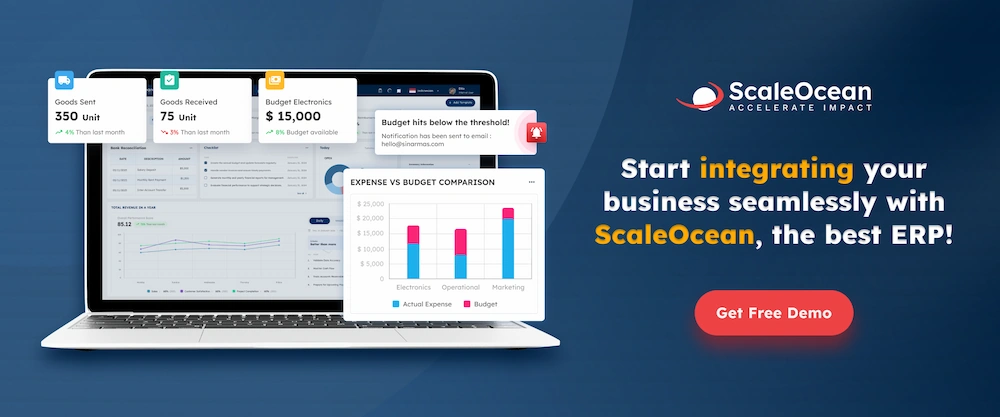Nowadays, the business landscape is experiencing transformations due to technological advancements. To keep up with the rapid changes, understanding the fundamentals of an ERP system is important. But what is ERP system? Simply put, an ERP (Enterprise Resource Planning) system is a software that integrates various functions within a company, such as finance, human resources, and supply chain, into one comprehensive framework. This enables businesses to streamline processes and improve data visibility across divisions.
The ERP system meaning does not only refer to a software, it represents a strategic approach to managing and optimizing enterprise operations. By centralizing data, an ERP system facilitates better decision-making and efficiency. We’ll go into more detail about ERP in this post and how it might change a business’s operational dynamics.

1. ERP System Meaning
What is ERP system? ERP system (Enterprise Resource Planning) is a software solution that organizes and combines a company’s essential activities into a single integrated system. Accounting, warehouse management, human resources, customer relationship management, and other activities are all part of this system, which enables multiple departments to effectively access and exchange data.
An ERP system’s main goal is to improve organizational efficiency by simplifying processes and decreasing duplicate jobs, resulting in greater communication, enhanced production, and improved data quality. ERP systems assist firms in maintaining consistency and visibility across all company functions, allowing for better informed decision-making and strategic planning.
Also Read:
Free Online ERP System Demo: Why Is It Important?
2. The Importance of ERP System
An ERP system is important for several conclusive reasons, mainly revolving around its ability to enhance the efficiency and effectiveness of business operations. Here are the reasons why ERP system is important for your business.
a. Integrated Business Processes
An ERP system eliminates the compartmentalization of departments by integrating different business processes into a cohesive unit, including essential HR software functions. This improves the flow of information and actions between areas like sales, finance, and operations, ensuring that everyone is working with the same data. This integration reduces process cycles and errors caused by miscommunication, leading to smoother operations and better collaboration across the organization.
b. Improved Data Accuracy and Consistency
By centralizing data storage, ERP systems ensure that every department uses the same information for work. This eliminates discrepancies that usually occur when departments use separate systems. Accurate data is important for maintaining operational efficiency and reliability, as it affects everything from order fulfillment to financial reporting. Consistent and trustworthy data contributes to operational integrity and stakeholder confidence.
c. Enhanced Decision-Making
ERP systems provide sophisticated analytical capabilities for processing complicated data and presenting it in an understandable way. Decision-makers can support detailed reports and dashboards to track performance metrics and identify trends, enabling proactive management and strategic planning. This real-time data access allows executives to make quicker, more informed decisions that align with the company’s long-term goals.
d. Scalability
As businesses grow, their operations become more complex. ERP systems are designed to accommodate this growth without the need for a proportional increase in overhead. New functionalities and modules can be added as needed without disrupting existing operations. This scalability allows organizations to extend their operations, access new markets, and respond to changes without outgrowing their core systems.
e. Regulatory Compliance and Risk Management
ERP systems provide capabilities that assist companies in complying with industry-specific requirements, such as GDPR for data protection and SOX for financial reporting. These solutions automatically update to follow changes in rules, allowing businesses to avoid penalties for noncompliance. Additionally, ERP systems enhance grant applications by ensuring compliance with the financial and operational criteria often required for business grants.
Furthermore, by offering visibility into all elements of the organization, ERP systems assist in identifying and mitigating hazards before they become major issues.
3. 7 Main Advantages of ERP
The main advantages of an Enterprise Resource Planning (ERP) system are numerous, significantly impacting various aspects of business operations. Here are the main benefits.
a. Enhanced Productivity
ERP systems streamline business operations by automating routine tasks such as data entry, order processing, and payroll. This automation reduces the amount of time workers spend on manual, repetitive operations, freeing them to focus on more strategic activities that create value to the organization. Moreover, ERP systems, including mobile ERP software, facilitate smoother workflows and quicker access to information, reducing bottlenecks and enhancing the overall productivity of the workforce.
b. Integrated Information
One of the most significant advantages of an ERP system is its ability to integrate data from various departments into a single, unified system. This integration ensures that information from sales, accounting, inventory, and customer service is consistent and easily accessible. This complete perspective of data not only removes data silos, but it also guarantees that decision-makers have a thorough grasp of the company landscape, which is critical for making effective decisions.
c. Accelerated Reporting and Planning
ERP system is equipped with advanced reporting tools that can generate real-time reports and analytics. These tools provide critical insights into business performance, enabling timely and accurate decision-making. In addition, contract management can be seamlessly integrated into the ERP system, allowing businesses to monitor contract performance and obligations alongside financial and operational data.
Furthermore, ERP systems streamline the planning process by integrating financial and operational data, facilitating more accurate forecasts and budgets. This accelerated reporting and planning capability enables businesses to respond quickly to market changes and internal dynamics.
d. Simpler IT Management
ERP simplifies IT administration by integrating several company operations into a single system. This consolidation results in fewer systems for IT professionals to install, manage, and troubleshoot, lowering IT workload and expenses. Furthermore, ERP suppliers frequently give upgrades and technical support, ensuring that the system stays current and safe without requiring substantial in-house knowledge.
e. Increased Operational Adaptability
ERP systems are designed to support a variety of operational structures, workflows, and procedures. They offer customization and configuration options that allow businesses to tailor the system to their specific needs. This adaptability is important for businesses to respond to changing market conditions, regulatory requirements, and evolving business goals, allowing them to pivot operations as needed without disrupting their core systems.
f. Standardized Business Processes
ERP systems enforce standardized business practices across the business by codifying these practices into the software. Standardization ensures consistency in processes and data management, regardless of the department or geographic location. This uniformity not only improves efficiency, but also helps maintain quality control and compliance with industry standards and regulations.
g. Cost Savings
By improving efficiencies and streamlining operations, ERP systems lead to significant cost savings. These savings are achieved through improved inventory management, optimized supply chain processes, reduced IT expenses, and lower operational redundancies. Additionally, the ability of ERP systems to improve decision-making can prevent costly errors and ensure that resources are used efficiently across the organization.
4. How Does ERP System Work?
An ERP (Enterprise Resource Planning) system works by centralizing all the core processes of a business into a single, integrated software platform. This platform gathers data from various departments such as finance, HR, manufacturing, supply chain management, and customer relations, and makes it accessible across the company in real time. For businesses in Singapore, ERP systems can also integrate with IRAS to streamline tax reporting and compliance, ensuring accurate and efficient management of financial data. This removes data silos and guarantees that all departments have access to the same information.
The ERP software uses a shared database to process this data, allowing for more efficient operations and real-time changes. As a consequence, firms may automate and streamline their operations, boost cross-industry collaboration, and make more efficient data-driven choices. Custom ERP software enables businesses to adopt a centralized approach not only improves operational efficiency, but it also facilitates strategic planning and management throughout the business.
5. Conclusion
In conclusion, understanding what is ERP system meaning offers significant advantages for any business looking to streamline operations and enhance efficiency. An ERP system integrates critical business functions into a single platform, promoting seamless communication and real-time data access across departments.
This comprehensive approach not only illustrates what does ERP system meaning, but also demonstrates how these systems may change business dynamics by allowing for wiser, data-driven decisions. Whether you’re learning about ERP systems for the first time or thinking about using one, the benefits are apparent, offering a solid platform for corporate development and operational success.



 Click to Chat!
Click to Chat!